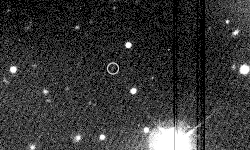Thrymr (moon)
Thrymr /ˈθrɪmər/, or Saturn XXX, is a natural satellite of Saturn. It was discovered by Gladman and colleagues in 2000, and given the temporary designation S/2000 S 7. Its name comes from Norse mythology, where Thrymr is a Jotun.
 Discovery images of Thrymr (cirlced) taken by the CFHT in September 2000 | |
| Discovery | |
|---|---|
| Discovery date | 2000 |
| Designations | |
Designation | Saturn XXX |
| Pronunciation | /ˈθrɪmər/[1] |
Named after | Thrymr |
| S/2000 S 7 | |
| Adjectives | Thrymian /ˈθrɪmiən/ |
| Orbital characteristics [2] | |
| 20474000 km | |
| Eccentricity | 0.470 |
| −1094.3 days | |
| Inclination | 176.0° |
| Satellite of | Saturn |
| Group | Norse group |
| Physical characteristics | |
Mean diameter | 8+50% −30% km[3] |
| 38.79±0.25? h[3] | |
| 23.9 | |
Thrymr is about 7 kilometres in diameter, and orbits Saturn at an average distance of 20,810 Mm in 1120.809 days. It may have formed from debris knocked off Phoebe. The Thrymian orbit is retrograde, at an inclination of 175° to the ecliptic (151° to Saturn's equator) and with an eccentricity of 0.453. Its rotation period is 38.79±0.25 hours.[3]
Its name was announced in its oblique form Thrym in IAU Circular 8177. However, the IAU Working Group on Planetary System Nomenclature later decided to add the nominative suffix -r to the root Thrym.
References
- /ˈθrɪm/ for 'Thrym-' in Merriam-Webster's Encyclopedia of Literature (1995)
- S.S. Sheppard (2019), Moons of Saturn, Carnegie Science, on line
- Denk, T.; Mottola, S. (2019). Cassini Observations of Saturn's Irregular Moons (PDF). 50th Lunar and Planetary Science Conference. Lunar and Planetary Institute.
- IAUC 7538: S/2000 S 7, S/2000 S 8, S/2000 S 9 December 7, 2000 (discovery)
- MPEC 2000-Y15: S/2000 S 1, S/2000 S 2, S/2000 S 7, S/2000 S 8, S/2000 S 9 December 19, 2000 (discovery and ephemeris)
- IAUC 8177: Satellites of Jupiter and Saturn August 8, 2003 (naming the moon Thrym)
- IAUC 8471: Satellites of Saturn, January 21, 2005 (correcting the name)
.jpg.webp)